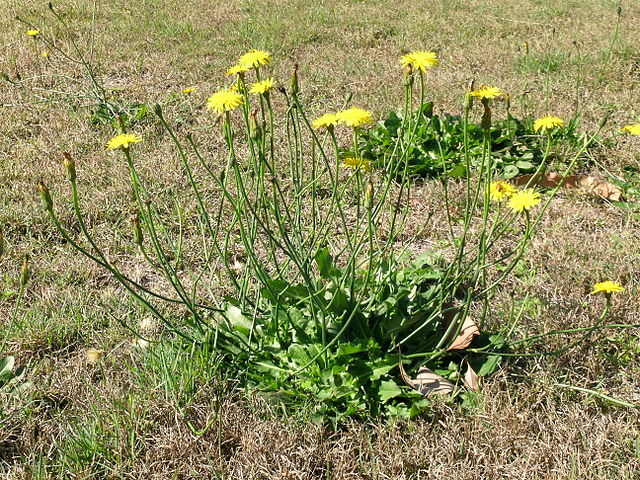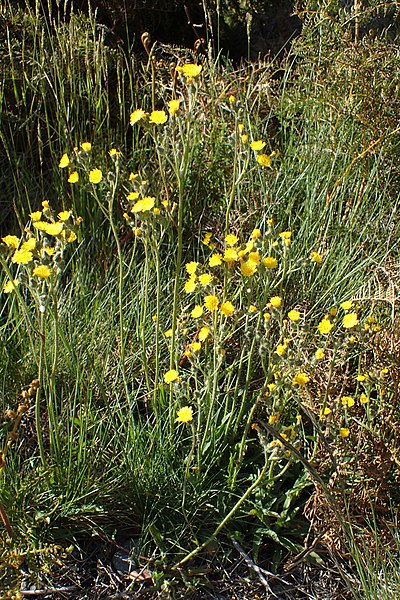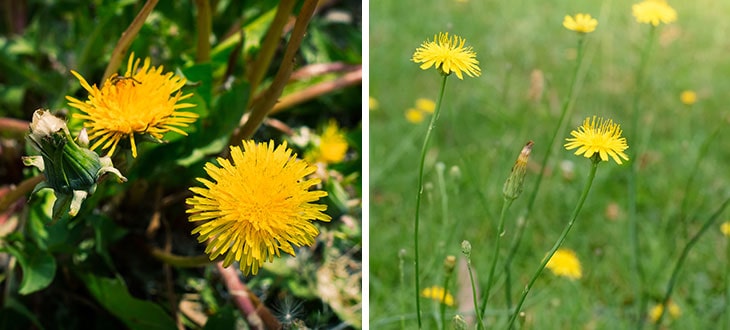False Dandelions: 5 Weeds That Look Like Dandelions
Did you find dandelions or weeds that looks like dandelions, also called false dandelions? Here are several plants similar in aspect to dandelions.
Dandelions (Taraxacum officinale), also known as common dandelions, are perennial broadleaf herbaceous weeds in the family Asteraceae, genus Taraxacum. These plants are native to Europe and Asia but have been naturalized through most temperate regions of the world.
The plant has a deep taproot, forms a rosette of green toothed leaves at the base of the plant, and a hollow upraised long stem that produces a yellow flower on the top. The entire plant contains a white milky latex sap.
Dandelions are especially known for producing yellow flower heads that turn into puffballs (also called blowballs or clocks) and are dispersed by the wind.
Common dandelions are versatile weeds, and because of their intrusive way of spreading, resistance to herbicides, and adaptability to different environmental conditions, they are considered noxious weeds in various regions.
However, dandelion also has several positive attributes.
They are edible.
Dandelion leaves, flowers, and roots are all edible. The young leaves are often used in salads, and the other parts are more frequently utilized in teas.
Contain vitamins and antioxidants.
Dandelion is also believed to have played an important role in traditional medicine for centuries. Among its properties, it is known for reducing inflammation, lowering cholesterol and blood pressure, and regulating blood sugar.
However, there is little research regarding the health benefits of dandelions. Hence, it is recommended to be used with caution for this purpose and only after consultation with a specialist.
Provide nectar and pollen to beneficial insects.
Dandelions provide food for many species of pollinating insects and are especially important in early spring when they are some of the few plants in bloom.
Now that you know a few things about dandelions let’s get back to the original purpose of this article, to help you recognize real dandelions from false dandelions.
False dandelion is a common name for several plants comparable in look and features to dandelions. In essence, they may have several similarities to dandelions, including the shape of the leaves, the production of yellow flowers with a similar structure, or the fact that the blooms turn into puffballs for propagation.
Below are several weeds that look like dandelions:
Contents
1. Catsear (Hypochaeris Radicata)

Hypochaeris radicata is a perennial weed native to Europe but introduced to many other regions of the world. It is commonly known as catsear, cat’s-ear, flatweed, hairy cat’s ear, or false dandelion (term that generally includes other dandelion-like plants as well).
Catsear is one of the weeds most often confused with dandelion because of the many similarities between these two plants.
Hypochaeris radicata forms a basal rosette of green lance-shaped leaves with toothed or irregular rounded lobes. These have a rough surface and are covered with simple hairs on both the upper and lower surfaces. The leaves release a milky sap when broken.
When flowering, catsear develops leafless, stiff, usually forked flower stalks, and at the top of each produces yellow flower heads similar to the ones of dandelions. Hypochaeris radicata also forms dandelion-like wind-dispersed seed heads.
2. Coast Dandelion (Agoseris Apargioides)

Agoseris apargioides is a species of perennial weeds native to the Pacific coast of the United States, where it grows largely on coastal dunes. It is also known as coast dandelion, seaside agoseris, or seaside false-dandelion due to its resemblance to dandelions.
Coast dandelion is part of the Asteraceae family, popularly known as the sunflower family. Three other subspecies of this plant are known to grow in various parts of California.
The leaves of this weed are green, slender to broad, and usually have rounded lobes along the margins (this can vary from one subspecies to another). They grow as low rosettes above the sand, and sometimes are half-buried in the sand.
The stems are rhizome-like, unbranched, and during its blooming period, it produces dandelion-like yellow flower heads. Also similar to dandelions, parts of this weed contain a milky sap.
3. Narrowleaf Hawksbeard (Crepis Tectorum)

Crepis tectorum is a plant native to Europe, Central Asia, and parts of China and introduced to many parts regions of the world. It is also known under names as the narrowleaf hawksbeard or narrow-leaved hawk’s-beard.
Narrowleaf hawksbeard can be identified through its slender, alternate, pointed, toothed, and or lobed green leaves that sometimes have curled-inward margins. It has a tall, upright main stem that branches toward the top into multiple flower stalks and produces yellow, dandelion-like flower heads on top of each.
Crepis tectorum can be found virtually in any sunny and moist place. It grows in recently disturbed sites and thrives in a variety of soil types. In many regions, the narrowleaf hawksbeard is considered an invasive weed.
Crepis genus contains about 200 different species of plants. Many of them are also similar in look to dandelions.
4. Meadow Hawkweed (Pilosella Caespitosa)

Pilosella caespitosa is a perennial weed in the family Asteraceae, native to Europe, but introduced as an ornamental plant to North America and other regions. It is commonly known as meadow hawkweed, yellow hawkweed, and several other names.
It is a drought-tolerant plant and prefers well-drained soils. It is often spotted in neglected landscapes, abandoned grasslands, open spaces, dump sites, and along roadsides. Due to its way of spreading through rhizomes, stolons and and wind-dispersed seeds, it is considered an invasive weed in many regions.
The leaves of meadow hawkweed grow as a basal rosette. Are green, long, elliptical, not lobed, and present hairs on both sides.
The stems are long, upright, unbranched, leafless, present dense, blackish hairs and emit milky juice when broken. On their tops, the weed produces clusters of yellow flower heads. At maturity, the flowers turn into blowballs of seeds that are dispersed by the wind.
Not only meadow hawkweed looks like dandelions but other species of the Pilosella genus as well.
5. Bristly Hawkbit (Leontodon Hispidus)

Leontodon hispidus is a perennial plant native to Europe but also introduced to North America. It is also known as bristly hawkbit or rough hawkbit.
It is usually found growing in meadows, fields, or other disturbed environments, in sunny spots and well-drained soils.
The leaves grow in a basal rosette, are simple, toothed, and can be lobed or unlobed, and there may present fine hairs on their surface. The stems grow upright and rarely branched.
During summer to fall, the bristly hawkbit bears yellow flowerheads similar to dandelion. These later turn in seed-heads that are dispersed by the wind.
Besides Leontodon Hispidus, other species in the genus Leontodon also have similarities to common dandelions.
Final Word
These are only a few of the plants that are often mistaken with dandelions and which are sometimes called false dandelions due to their similarities.

